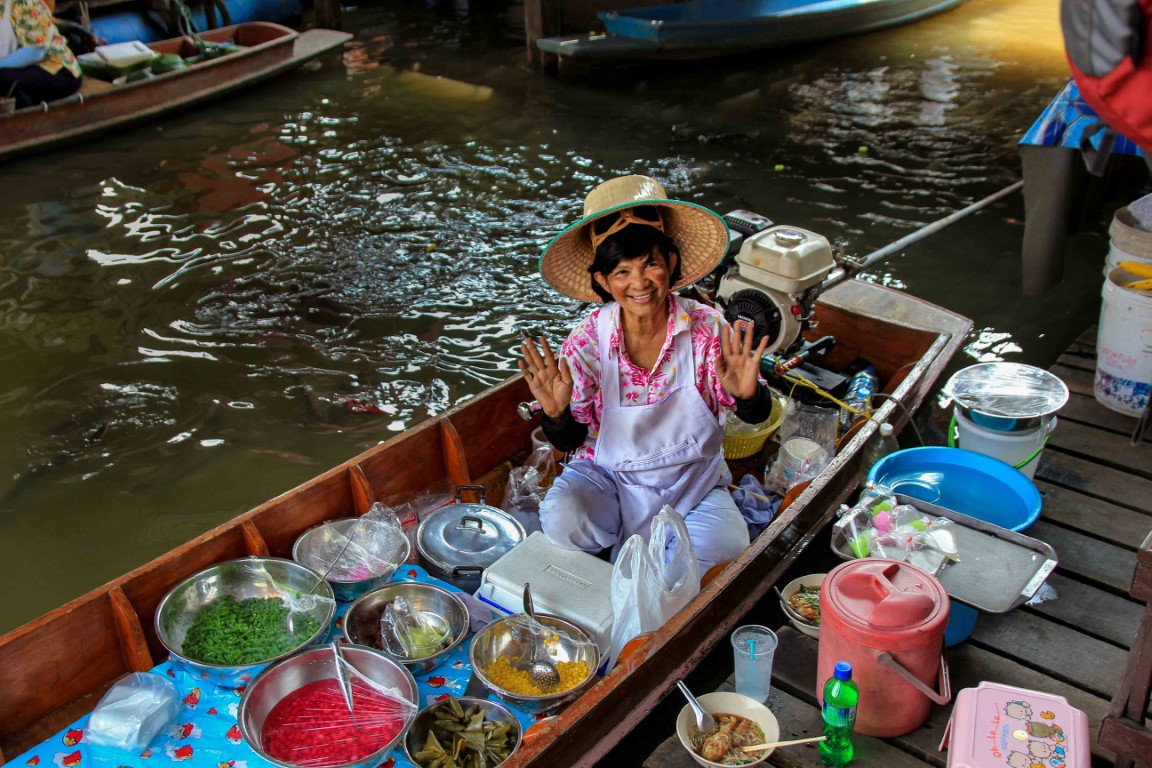Afloat in Tradition: The Timeless Appeal of Thailand’s Floating Markets
Introduction
Thailand’s floating markets are living museums of motion and color, where trade drifts along calm canals instead of crowded streets. Generations of vendors guide wooden boats laden with fruits, spices, flowers, and freshly cooked meals, creating a captivating dance of commerce upon water. Each ripple carries centuries of heritage — proof that Thailand’s lifelines have always flowed through its rivers.
To visit these markets is to see Thai life at its most authentic: gracious smiles, gentle bargaining, and the irresistible aroma of sizzling coconut pancakes and grilled river prawns. The experience is not just about what you buy, but about what you witness — a community in harmony with the water that sustains it.
The Markets – Thailand’s Floating Icons
Damnoen Saduak Floating Market (Ratchaburi Province)
The most famous and photogenic of Thailand’s floating markets, Damnoen Saduak bursts with life each morning. Vendors in conical hats paddle through the canal, selling tropical fruit, flowers, and traditional snacks. Best visited early before crowds arrive, it remains an essential glimpse into Thailand’s trading past.
Amphawa Floating Market (Samut Songkhram Province)
A beloved weekend market where locals shop as much as tourists. Wooden shop-houses line the canal, while boats serve freshly grilled seafood and sweet desserts. As dusk falls, fireflies flicker among the trees — a magical reward for those who linger into evening.
Taling Chan Floating Market (Bangkok)
Smaller and more relaxed, this market is ideal for visitors seeking an authentic local feel within the city. Families gather on wooden platforms for lunch over the water, surrounded by music, flowers, and laughter.
Bang Noi & Tha Kha (Ratchaburi)
Hidden gems for those who prefer quiet exploration. Here, elderly vendors still sell home-grown produce and handmade goods, preserving a rhythm untouched by modern tourism.
The Experience – Where Culture Flows
A morning among the floating markets awakens every sense.
The melody of paddles against water, the chatter of vendors, and the fragrance of fresh herbs drifting through warm air form an unchoreographed symphony of life. Visitors can sample coconut ice cream, sip coffee brewed on floating stoves, and try regional specialties like boat noodles or mango sticky rice.
Beyond the flavors, the markets embody connection — between people, tradition, and the river itself. To glide slowly through the waterways is to glimpse Thailand’s beating heart, where modern life and ancient customs float side by side.
🕰️ Suggested Floating Market Itinerary
Day 1 – Bangkok Arrival & Orientation
Evening visit to Taling Chan Market for dinner on the water.
Overnight in Bangkok riverside hotel.
Day 2 – Damnoen Saduak & Amphawa
Early-morning transfer (1.5 hrs from Bangkok).
Paddleboat tour through the market canals.
Visit Amphawa in the afternoon; enjoy street-food dinner and sunset by the river.
Day 3 – Hidden Markets & Firefly Cruise
Explore Tha Kha or Bang Noi floating markets for a peaceful experience.
Optional evening boat ride among firefly-lit mangroves.
Return to Bangkok.
💶 Pricing & Services
| Package Type | Duration | Accommodation | Price / Person (€) | Inclusions |
|---|---|---|---|---|
| Floating Market Explorer | 1 Day | — | €180 | Private transfers, paddleboat ride, tasting samples, English-speaking guide |
| Weekend Waterways Journey | 2 Days / 1 Night | 3★ Riverside Hotel | €370 | All Explorer inclusions + Amphawa evening tour, seafood dinner, breakfast |
| Cultural Canals Experience | 3 Days / 2 Nights | 4★ Boutique Hotel | €610 | All Journey inclusions + hidden market visit, firefly cruise, Thai cooking class |
Sample Options
Amphawa Homestay: €90 / night – local family guesthouse with canal view.
Riva Surya Bangkok: €220 / night – modern riverside luxury.
Samut Songkhram Eco-Lodge: €150 / night – sustainable stay amid coconut groves.
All prices include taxes, transfers, and licensed cultural guide. Meals feature local specialties prepared fresh on site.
🌿 Optional Add-Ons
🍜 Thai Cooking Workshop by the Canal: €55 pp
🚣 Private Long-Tail Boat Tour at Sunrise: €45 pp
📸 Cultural Photography Session: €80 per couple
🕯️ Evening Firefly Boat Cruise: €35 pp
🛍️ Market Souvenir & Handicraft Tour: €25 pp
🌸 Practical Tips
Best Season: November – April (dry season; clear skies and calm waters).
Timing: Arrive before 9 AM to avoid crowds and heat.
Etiquette: Avoid touching goods without asking; carry small bills for easy transactions.
Attire: Light clothing and sun protection; markets are mostly outdoors.
Sustainability: Support vendors who avoid plastic containers and use local ingredients.
Conclusion
Thailand’s floating markets are timeless theaters of everyday life — places where commerce flows with culture and the river tells stories older than the city. Among the laughter of vendors and the shimmer of sunlight on water, visitors find not only souvenirs but something rarer: connection. These markets embody the essence of Thailand — graceful, enduring, and forever afloat in tradition.

.jpg)

.webp)
.jpg)
.jpg)
.jpg)
.jpg)
.jpg)
.jpg)
.webp)
.jpg)
.jpg)
.jpg)
.jpg)
.jpg)
.jpg)
.jpeg)
.jpg)